ASTM C1350 Radiological Analysis of Irradiated Surface Deposits
ASTM C1350 provides a standardized method for radiological analysis of irradiated surface deposits, which is crucial in various sectors such as nuclear fuel cycle facilities, waste management sites, and decommissioning projects. This service ensures compliance with safety regulations while minimizing risks associated with handling radioactive materials.
The ASTM C1350 procedure involves the collection and preparation of samples from surfaces suspected of containing radiological contaminants. Specimens are then analyzed using gamma spectroscopy to determine the presence and concentration levels of specific radionuclides. This method is particularly useful for identifying contamination hotspots, assessing remediation effectiveness, and ensuring that regulatory limits are not exceeded.
One of the key aspects of ASTM C1350 is its focus on minimizing exposure during sample collection. This includes wearing appropriate personal protective equipment (PPE), using remote sampling techniques where possible, and following strict protocols to prevent contamination spread. The service also emphasizes the importance of proper documentation throughout the process, from initial site assessment through final reporting.
Another important consideration is the choice of analytical methods. While gamma spectroscopy is often used due to its sensitivity and specificity, other techniques such as alpha spectrometry or beta counting may be employed depending on the nature of the radionuclides present. The selection of these methods ensures accurate results that can be relied upon for decision-making purposes.
The ASTM C1350 procedure also includes stringent quality control measures to ensure reliable data. These include duplicate sampling, inter-laboratory comparisons, and validation against certified reference materials (CRMs). By adhering to these standards, the service guarantees high-quality results that meet regulatory requirements and industry best practices.
In summary, ASTM C1350 radiological analysis of irradiated surface deposits is a critical tool for maintaining safety in environments where radioactive materials are present. It plays a vital role in ensuring compliance with health and environmental regulations while providing valuable insights into contamination levels and trends over time. This service helps organizations make informed decisions regarding remediation efforts, waste management strategies, and overall operational practices.
Why It Matters
The importance of ASTM C1350 cannot be overstated, especially in industries dealing with nuclear fuel cycles or handling radioactive materials. By providing a standardized method for analyzing irradiated surface deposits, this service ensures consistent and accurate results across different facilities and laboratories.
- Ensures Compliance: Regulatory bodies rely on reliable data to enforce safety standards. ASTM C1350 helps ensure that all testing aligns with these requirements.
- Promotes Safety: Accurate analysis allows for early detection of potential hazards, enabling timely interventions before they escalate into serious incidents.
- Supports Decision Making: Reliable data from ASTM C1350 can inform critical decisions about site management, waste disposal practices, and long-term planning.
The service also contributes to public trust by demonstrating a commitment to transparency and accountability in handling radioactive materials. This is particularly important given the sensitive nature of these substances and their potential impact on human health and the environment.
Moreover, ASTM C1350 fosters collaboration among stakeholders within an organization, ensuring that all parties involved are working towards common goals. It encourages open communication about findings and actions taken based on those results.
Applied Standards
ASTM C1350 is part of a broader set of standards aimed at ensuring consistency in radiological analysis across various sectors. These include:
- ASTM C769: Method for Determining the Activity Concentration of Radionuclides Present on Surfaces by Gamma Spectrometry.
- ISO 15046: Guidance on Environmental Radiation Monitoring in Nuclear Facilities.
- EN 13729: Quality Management Systems for Radioactive Waste Management.
These standards complement ASTM C1350 by providing additional context and support for comprehensive radiological assessments. Together, they form a robust framework that enhances the reliability of testing procedures and promotes best practices in handling radioactive materials.





